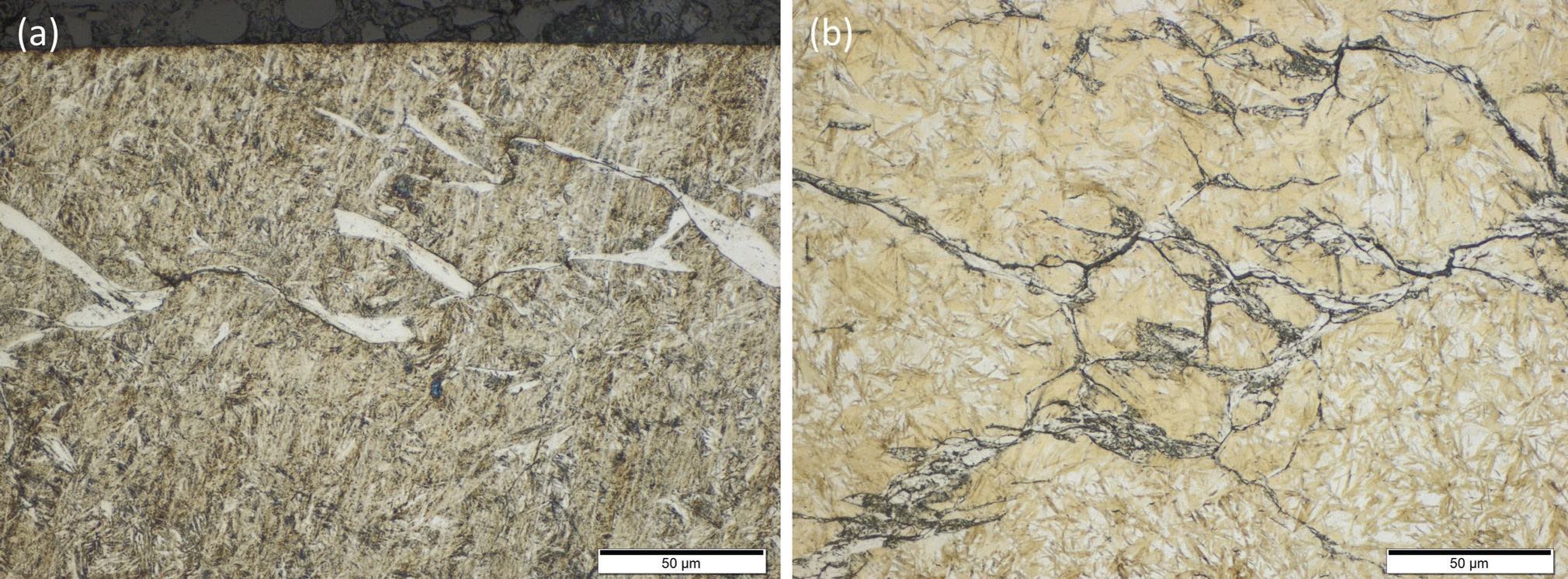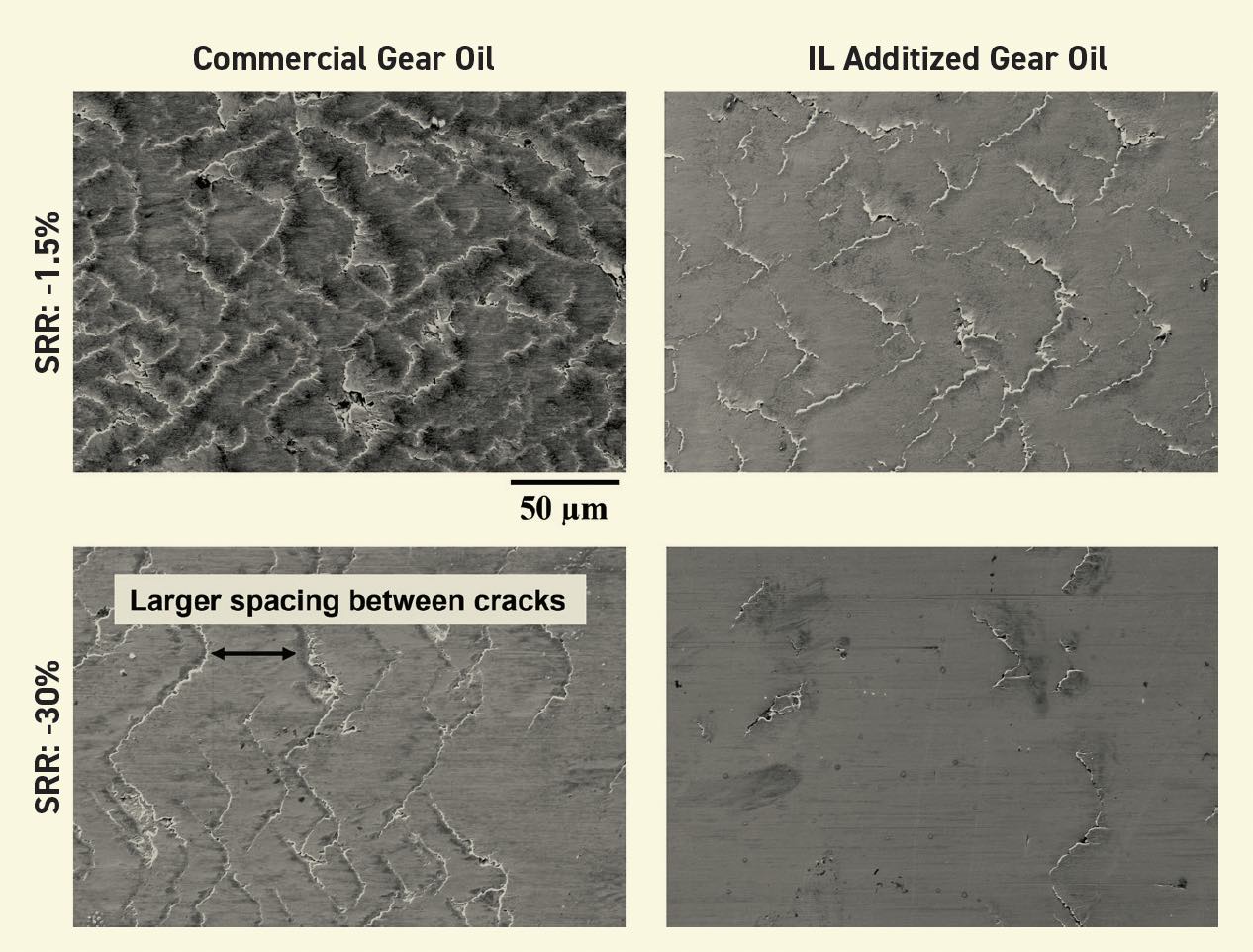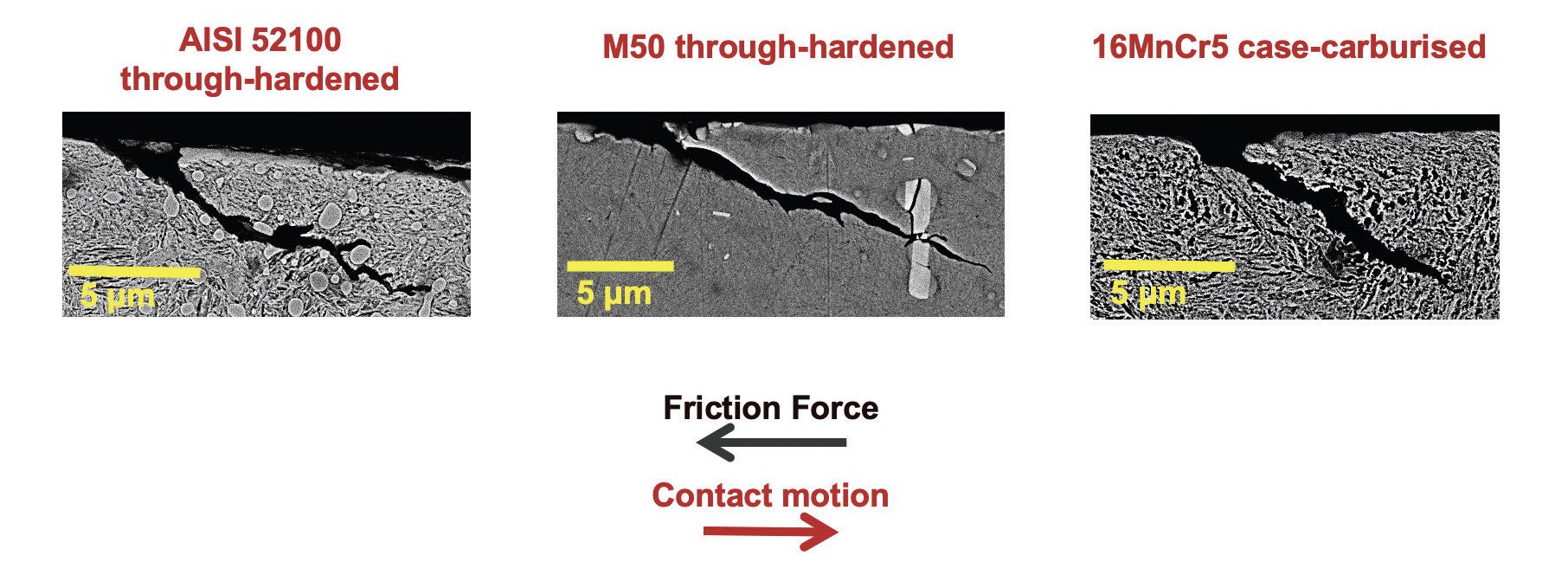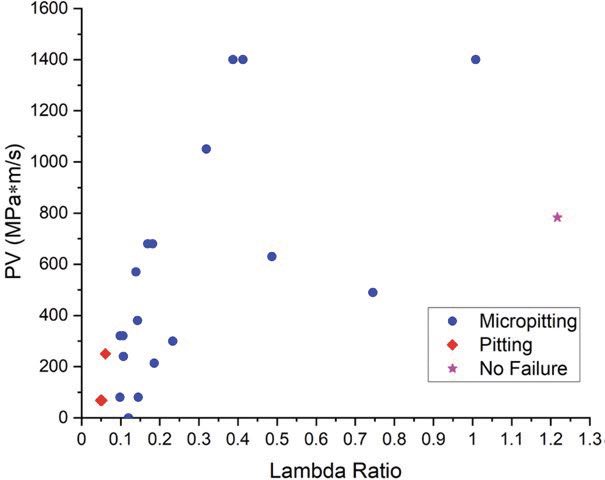KEY CONCEPTS
•
Rolling contact fatigue (RCF) failures are often detected on the surfaces of bearings, gears, etc.
•
Researchers experiment with different materials and study RCF under different operation conditions to reduce RCF impact.
•
Surface treatment can affect one or more connected properties in different ways.
Rolling contact elements, especially gears and bearings, experience a wide variety of failure modes including micropitting, spalling, white etching cracks (WECs), cracking, etc. A wide variety of research has been conducted by different research groups globally to enhance their rolling contact fatigue (RCF) life. This includes observing the effect of different case hardening techniques including carburizing and nitriding, revealing effect of crucial phases such as retained austenite (RA), developing novel coatings such as diamond-like carbon (DLC) and carbon black and understanding fundamental crack initiation and propagation under various contact conditions. Recent research studies also focus on specific applications such as agricultural sectors, wind energy, space applications, etc.
This article focuses on capturing a holistic viewpoint on these recent developments and future perspectives with key discussions majorly focused on concurrent findings on surface properties and characteristics of materials that experience rolling contacts such as gears, bearings, cams, etc. Specifically in this article, experts share how they became interested in RCF, and new directions that different research groups are focused on to enhance knowledge on the matter. In addition, experts share different aspects such as heat treatment to modify specific phase and/or microstructure of the surface, novel coatings, post-processing treatments such as shock-peening, impact treatments, etc., to further change surface properties.
Experts’ current research activities
STLE member Dr. Sougata Roy, assistant professor, department of mechanical engineering, Iowa State University, has been working in the RCF field for the last 10 years. Roy comments about his research activities: “Initially I started working on understanding the role of RA in major RCF failure modes—in particular micropitting, macropitting or spalling and WEC formation in carburized steel for gear application. RA is a crucial phase in steel, and I worked on varying RA percentages in AISI 8620 steel by modifying the carburizing heat treatment schemes in different batches while sample preparation.”
In another project, Roy focused on running-in phenomena and explored the evolution of hardness and tribofilm growth during running-in process of carburized steel under boundary lubrication regime. “Significant changes on surface roughness characteristics can be observed during micropitting since micropitting is a surface driven failure mode,” he says. Roy published an article presenting the correlation between evolution surface roughness and progression of micropitting during RCF.
1 While these research activities were focused on surface roughness and materials-dependent RCF behavior, later Roy explored lubrication behavior during the RCF process. He presented the major potential of phosphonium-based ionic liquids as antiwear and antipitting additives for low-viscosity rear axle lubricants. “We were able to show enhanced protection against surface cracking and micropitting using an ionic liquid additized lubricant having viscosity level half of conventional gear oil. In another lubrication-based effort, I studied the potential of copper(II) oxide (CuO) and tungsten carbide (WC) nanoparticles-based nanofluids on their micropitting life enhancement in carburized steels,” Roy shares.
STLE member Dr. Amir Kadiric, a reader in mechanical engineering, department of mechanical engineering, Imperial College London, also briefly describes his research activities in the RCF field. He says that the Tribology Group at Imperial has a long history in RCF research. Some of the past highlights include the 1980s work on the impact of debris on rolling bearing fatigue, which formed the basis for the now well-known contamination factor in ISO bearing life theory, and the 1990s work on the development of test rigs for pitting and micropitting studies, which eventually culminated in the widely used triple-disc micropitting rig (MPR). Kadiric shares: “My recent research in the field focuses on the surface-initiated RCF, which is the dominant mode in modern machines since they often operate under low specific film thicknesses (low lambda ratios). The major aspect of this work is that, rather than looking only at the final failure, it attempts to better understand the actual growth of RCF cracks, from very early stages when they are only tens of microns long, to when they eventually form the final pit. This is a necessary step in improving our predictions of RCF lives of machine elements such as bearings and gears, particularly the predictions of the ‘remaining useful life,’ i.e., life after an initial RCF crack is formed and detected, which are not possible with current, largely empirical, approaches.” Kadiric adds that other aspects of his recent RCF research include the effect of lubricant formulation and surface treatments, such as black oxide and steel composition on RCF damage.
STLE member Dr. Jeremy Wagner, technical lead, drivetrain tribology and system simulation, John Deere Product Engineering Center, says that his research has primarily focused on understanding run-in and RCF life at very low lambda conditions (λ < 0.5),
2,3,4 which is important for applications that have low speed and high load, like off-highway vehicles. One focus area of this work has been on identifying a failure mode transition and the contributing factors. Additional focus areas have included correlating bearing RCF life in the field to calculated life, S-N curve development, the effect of additives and tribofilms, simulation and life models and RCF test acceleration.
Discussion on key findings on RCF
Roy says that his interest to study deep into RCF started within the topic of RA, which is a crucial phase of steel that has a significant impact on its wear and fatigue life. He shares that in the first phase of his doctoral study at Iowa State University, he elucidated the impact of different heat treatment routes on controlling the RA and micro-tribological behavior of carburized steel.
5 He demonstrated that by combined effect of increased RA and surface hardness, the wear resistance of carburized steel can be improved by up to 40%. Roy also presented the laser surface treatment as an alternate route to heat treat the steel components used in drivetrains. He further shares that he studied the effect of the two most critical laser treatment parameters (laser scanning velocity and shielding gas) to control RA on the sample surface.
6 Roy says that he and his team succeeded in improving the surface hardness of laser treated steel by a maximum of 45%, using the proper selection of scanning velocity and shielding gas. During the next phase of his doctoral study, Roy concentrated on the three crucial RCF failure modes observed in gears and wind turbine bearings, namely micropitting,
7,8 spalling
9 and WEC formation.
10 Roy says that he developed novel protocols to track surface evolution during micropitting initiation and propagation using white light interferometry. He also captured martensitic phase transformation using a micro- X-Ray diffraction technique to address martensitic phase transformation during running-in and later periods of RCF life for drivetrain components. Roy observed that the micropitting life of samples can be improved up to 12 times by increasing RA on the surface. In case of macropitting or spalling, RA content as well as subsurface cracks played crucial roles in failure of components. “Industrial scale drivetrain bearings, particularly those used in wind turbines, often exhibit WEC-induced premature macropitting or spalling well before reaching their RCF design life,” Roy says. He adds: “A general common root cause of WEC networks in field bearings is still unknown. However, the microstructural alterations that appear in conjunction with the cracks must form due to local excess in energy causing recrystallization or atomic diffusion. An investigation in collaboration with Argonne National Laboratory provided valuable insights on the impact of RA on WEC morphologies of failed specimens— WEC networks that formed in the samples with higher levels of RA contained a larger number of crack branches, and the white etching area (WEA) adjacent to the crack faces was less developed
(see Figure 1).”
 Figure 1. Effect of retained austenite on white etching crack (WEC) morphology. (a) Low RA and (b) high RA samples failed in spalling mode after WEC formation in the sub-surface region.10
Figure 1. Effect of retained austenite on white etching crack (WEC) morphology. (a) Low RA and (b) high RA samples failed in spalling mode after WEC formation in the sub-surface region.10
In the running-in focused investigation,
11 Roy and his team presented how the surface hardness of 16MnCr5 steel gets evolved during the running-in period, which is very important in the RCF process and can impact RCF life significantly. The results showed that a higher initial composite roughness led to greater gains in hardness as compared to higher contact pressure during the running-in process. “In another effort,
1 the evolution of amplitude and spatial parameters were investigated during RCF experiments on carburized samples with around 0%, 15% and 70% RA under boundary lubrication condition,” shares Roy. “The 0% RA samples failed due to early crack initiation and rapid crack propagation. The 15% and 70% RA samples showed initiation and propagation of micropitting. Significant propagation of micropitting was accompanied by changes in surface roughness parameters, specifically by a decreasing trend of skewness and increasing trend of kurtosis,” Roy adds.
Roy says that in the lubrication-focused efforts in RCF, the nanofluids consisting of 1% nanoparticles by weight and 1% by weight of oleic acid surfactant in polyalphaolefin (PAO) showed enhanced micropitting life as compared to standalone PAO.
12 These showed the great potential of select nanoparticles on impacting RCF life. “Stringent government regulation in exhaust emission and increased demand for fuel economy are the prime contributors for deeper research in finding highperformance low-viscosity lubricants,” Roy explains. “Since the invention of lubrication applications of ionic liquids (ILs), it has been extensively studied for use in various engineering sectors, including high vacuums and high temperatures.” While working at Oak Ridge National Laboratory, he studied phosphonium phosphate
13 and phosphonium phosphinate
14 ILs for rear axle lubrication. Roy shares: “Test conditions were established to simulate contact conditions near pitch line and dedendum of gears when a vehicle is driven during cold start, highway towing and overload conditions. Although the viscosity of IL-based lubricants was around half of commercial SAE 75W-90 gear oil, it still demonstrated significantly improved surface protection in terms of surface crack reduction and wear reduction
(see Figure 2).” Roy adds: “Chemical interaction of ILs with sample surface and wear protection mechanisms were studied in detail by conducting scanning transmission electron microscopy (STEM) imaging of the focused ion beam (FIB) cross-sectioned tribofilms and non-contact optical profilometry-based techniques.”
 Figure 2. Surface topography of roller samples under commercial (left) and IL-based (right) lubricant cases.13
Figure 2. Surface topography of roller samples under commercial (left) and IL-based (right) lubricant cases.13
Kadiric also shares about how his interest to study deep into the particular areas on RCF developed and some of his key findings: “This research is multifaceted, but its overall aims are straightforward: to help extend the contact fatigue lives of machine elements and to improve our ability to predict these lifetimes, both of which can reduce maintenance and downtime costs and improve safety of many mechanical systems. By detecting very early RCF surface cracks, tens of microns in length, and monitoring their growth, we have been able to show
15 that crack propagation, rather than initiation, can consume the majority of the total RCF life.” Furthermore, Kadiric adds: “We have shown that for later phases of surface crack growth, it is possible to predict their propagation rates using linear elastic fracture mechanics approaches that are widely used in structural fatigue, including Paris’ law type equations.
16 This suggests that despite its many complexities, the fundamental mechanisms of RCF crack growth are the same as those for structural fatigue cracks.” The significance of this is far from purely academic— in practice it opens up the possibility of using well-established tools, widely used in classical fatigue engineering practice for prediction of fatigue lifetimes in structures, to improve our predictions of RCF lives in components such as bearings and gears. This is particularly relevant to predictions of remaining useful life I mentioned earlier,” he says. Other interesting findings are that steel composition has a significant influence on RCF crack propagation rates, with surface RCF cracks seemingly growing slower in M50 steel, for example, than in standard AISI 52100 through-hardened bearing steel or a typical case-carburized gear steel, Kadiric shares. He says: “The crack morphology also differs for different steels, and the 3D crack shape evolves over time, so that the common assumption of a half-penny shaped surface RCF crack is not always valid.” Figure 3 shows examples of typical early surface RCF cracks.
 Figure 3. SEM images showing typical morphology of early surface-initiated RCF cracks in different bearing and gear steels. Cracks generated in a triple-disc contact fatigue rig. (p0 = 3 GPa, SRR = -5%) mixed lubrication regime. Sections in rolling direction after polishing and etching. In all images, friction acts to the left and contact moves to the right. Figure courtesy of A. Kadiric and P Rycerz, Imperial College London.
Figure 3. SEM images showing typical morphology of early surface-initiated RCF cracks in different bearing and gear steels. Cracks generated in a triple-disc contact fatigue rig. (p0 = 3 GPa, SRR = -5%) mixed lubrication regime. Sections in rolling direction after polishing and etching. In all images, friction acts to the left and contact moves to the right. Figure courtesy of A. Kadiric and P Rycerz, Imperial College London.
Kadiric continues: “In regard to surface treatments, our recent RCF research has consistently shown that one of the primary ways in which such treatments can improve surface fatigue performance is by optimizing the running-in process, so that the magnitude of the asperity stresses, which are ultimately responsible for surface fatigue, is reduced.
17 The exact mechanism by which this is achieved varies between treatments, with for example black oxide promoting running-in of the surface on which it is applied,
18 whereas hard coatings, such as DLC, promote running-in on the opposing surface.” To achieve the desired effect of balancing wear and fatigue performance, care should therefore be taken to apply a given treatment to the correct surface in a tribopair, Kadiric says. “Interestingly, along with the reduction of friction, the optimization of this running-in process also is a primary way in which a lubricant formulation can improve contact fatigue performance—the aim in both cases is to get the right balance between wear and fatigue, which will maximize the component life,” he adds.
Wagner says that his interest to study deep in RCF was sparked by two things: “1.) My work on drivetrains for off-road vehicles for 25 years and 2.) the published literature on life adjustment factors for lambda ratio didn’t study deeply the case when λ < 0.5.” Wagner shares that in his work, it was discovered that for the oil tested,
2 there was a lambda ratio at which the failure mode changed from micropitting to pitting
(see Figure 4), and this failure mode transition was affected by the additive elements present in the tribofilm.
 Figure 4. Test failure modes, lambda ratio versus Hertzian pressure and sliding velocity (PV).2
Figure 4. Test failure modes, lambda ratio versus Hertzian pressure and sliding velocity (PV).2
Future research directions
While describing future directions for major research in surface engineering of rolling contact elements, Roy says that currently, a lot of different directions-based RCF investigations are being carried out by various groups across the globe. Some of them are fundamental studies such as understanding various RCF failure modes via analytical, computational and experimental efforts. Some studies are applied that focus on exploring novel coatings and/or surface engineering routes to enhance the RCF life of components. “A lot of efforts from lubrication aspects by introducing novel nanoparticles and ILs also are being carried out,” Roy states.
Adding to the above, Kadiric also shares his thoughts on some major research directions in surface engineering of rolling contact elements: “I think much of the new developments in this respect will be driven by the need to reduce the environmental impact of the relevant applications, and there are many ways to achieve this. If we are talking about making a step change in extending RCF lifetimes, then I think the best way to achieve this is through development of new materials that are better able to deal with surface-initiated damage in particular.” He explains: “Notwithstanding incremental changes, typical steels used for rolling bearings and gears are over 100 years old. Modern machines operate under thinner lubricant films and higher power densities, causing more asperity interactions and, hence, failures at the surface itself. In some novel applications, machine elements are subjected to harsh environments—for example, hydrogen.”
Kadiric adds that surface coatings can help in some situations, but too often they have limited lifetimes themselves. Ceramics are an excellent solution in selected cases but are often not cost effective. “Development of such new materials should make use of the accumulating knowledge on how surface RCF cracks initiate and grow, as discussed earlier,” he says. “A good example is the use of surface treatments that optimize the running-in process to subsequently reduce asperity stresses and, hence, surface fatigue. Another example is the recent attempts to develop new steels, which are better able to trap hydrogen to prevent it from adversely affecting fatigue lifetimes. The environmental impact of making and using such materials must not be forgotten, and the growing interest in ‘green steels’ is very welcome in this respect,” Kadiric states.
He continues: “Of course, simply reducing the downtime of machines or avoiding unnecessary component replacement can have an enormous positive environmental impact itself. I think the work on improving the models for RCF lifetime predictions, specifically focusing on surface initiation, crack propagation and remaining useful life, will form an important part of our ongoing efforts. These models are likely to be more deterministic than the current ones, but we must not forget that RCF failures are inherently a statistical phenomenon, and this is where I think some of the new machine learning methods may find a good use. An effective combination of machine learning applied to data from appropriate condition monitoring sensors and our evolving understanding of RCF physics has a potential to revolutionize our predictions of RCF lifetimes in practical applications.”
Wagner contributes to the topic of the future research directions with several ideas: “I think three things come to mind when we talk about surface engineering: 1.) surface texture, 2.) coatings and 3.) residual stress enhancement, typically by means of peening. Of these three items, I think residual stress enhancement is the area where more work would be beneficial, particularly the effect of different manufacturing processes on the residual stress magnitude.” He continues: “I also think there are three other areas that could benefit from additional research. The first is the effect of the near surface microstructure, specifically the first few microns, on the RCF performance.” Wagner explains that it is affected by the manufacturing process, and it has shown to be a factor in engine cylinder performance. “The second is how run-in affects RCF performance. It is commonly accepted that run-in improves RCF performance, but to my knowledge this has not been studied deeply or quantified. The third is the effect of the resulting tribofilm on the RCF performance,” Wagner shares.
Summary
Rolling contact elements are one of the most crucial components in machinery. Enhancing the operational life and reliability of these components is a long-studied topic of research, both via experiments and digital modeling. Modern machines utilize components which have superior surface finishes and clean lubricants but also operate under thinner lubricant films and higher power densities. Future research needs to account for one of the major challenges, which is that surface treatment can impact one or more connected properties in different ways; for example, as discussed in this article, increasing RA on the surface may help enhance micropitting life. In addition, future research should also focus on novel lubricants which need to be developed alongside metallurgical improvements for the new surfaces. Therefore, it is beneficial for the industry to continue sharing knowledge and progress with the developments of new innovative solutions aligned with sustainability and energy efficiency goals.
REFERENCES
1.
Roy, S., White, D. and Sundararajan, S. (2018), “Correlation between evolution of surface roughness parameters and micropitting of carburized steel under boundary lubrication condition,”
Surface and Coatings Technology, 350, pp. 444-452.
2.
Wagner, J. J. and Sundararajan, S. (2022), “Tribofilm characterization and residual stress changes in rolling/sliding contacts under low lambda conditions,”
Wear, 500-501, 204350, doi.org/10.1016/j.wear.2022.204350.
3.
Wagner, J. J. and Sundararajan, S. (2021), “Failure mode mapping for rolling/sliding contacts under low lambda conditions,”
Wear, 477, 203855, doi.org/10.1016/j.wear.2021.203855.
4.
Wagner, J. J., Jenson, A. D. and Sundararajan, S. (2017), “The effect of contact pressure and surface texture on running-in behavior of case carburized steel under boundary lubrication,”
Wear, 376-377, pp. 851-857, doi.org/10.1016/j.wear.2017.02.016.
5.
Roy, S. and Sundararajan, S. (2016), “The effect of heat treatment routes on the retained austenite and Tribomechanical properties of carburized AISI 8620 steel,”
Surface and Coatings Technology, 308, pp. 226-243.
6.
Roy, S., Zhao, J., Shrotriya, P. and Sundararajan, S. (2017), “Effect of laser treatment parameters on surface modification and tribological behavior of AISI 8620 steel,”
Tribology International, 112, pp. 94-102.
7.
Roy, S., Ooi, G. T. and Sundararajan, S. (2018), “Effect of retained austenite on micropitting behavior of carburized AISI 8620 steel under boundary lubrication,”
Materialia, 3, pp. 192-201.
8.
Ooi, G. T., Roy, S. and Sundararajan, S. (2018), “Investigating the effect of retained austenite and residual stress on rolling contact fatigue of carburized steel with XFEM and experimental approaches,”
Materials Science and Engineering: A, 732, pp. 311-319.
9.
Roy, S. and Sundararajan, S. (2019), “Effect of retained austenite on spalling behavior of carburized AISI 8620 steel under boundary lubrication,”
International Journal of Fatigue, 119, pp. 238-246.
10.
Roy, S., Gould, B., Zhou, Y., Demas, N. G., Greco, A. C. and Sundararajan, S. (2019), “Effect of retained austenite on white etching crack behavior of carburized AISI 8620 steel under boundary lubrication,”
Tribology Letters, 67: 40.
11.
Jenson, A. D., Roy, S. and Sundararajan, S. (2018), “The evolution of hardness and tribofilm growth during running-in of case carburized steel under boundary lubrication,”
Tribology International, 118, pp. 1-10.
12.
Roy, S., Jazaa, Y. and Sundararajan, S. (2019), “Investigating the micropitting performance of copper oxide and tungsten carbide nanofluids under boundary lubrication,”
Wear, 428, pp. 55-63.
13.
Roy, S., Speed, L., Viola, M., Luo, H., Leonard, D. and Qu, J. (2021), “Oil miscible phosphonium-phosphate ionic liquid as novel antiwear and antipitting additive for low-viscosity rear axle lubricants,”
Wear, 466, 203588.
14.
Roy, S., Stump, B. C., Luo, H., Leonard, D. and Qu, J. (2021), “Why does a phosphoniumphosphinate ionic liquid protect the contact surfaces from wear and micropitting but increase vibration when used as an additive in rolling-sliding lubrication?”
Tribology International, 159, 106949.
15.
Rycerz, P., Olver, A. and Kadiric, A. (2017), “Propagation of surface initiated rolling contact fatigue cracks in bearing steel,”
International Journal of Fatigue, 97, pp. 29-38.
16.
Kunzelmann, B., et al. (2023), “Prediction of rolling contact fatigue crack propagation in bearing steels using experimental crack growth data and linear elastic fracture mechanics,”
International Journal of Fatigue, 168, 107449.
17.
Ueda, M., Spikes, H. and Kadiric, A. (2019), “In-situ observations of the effect of the ZDDP tribofilm growth on micropitting,”
Tribology International, 138, pp. 342-352.
18.
Ueda, M., Spikes, H. and Kadiric, A. (2022), “Influence of black oxide coating on micropitting and ZDDP tribofilm formation,”
Tribology Transactions, 65 (2), pp. 242-259.
Dr. Yulia Sosa is a freelance writer based in Peachtree City, Ga. You can contact her at dr.yulia.sosa@gmail.com.